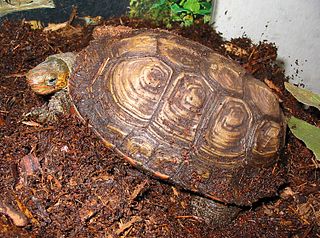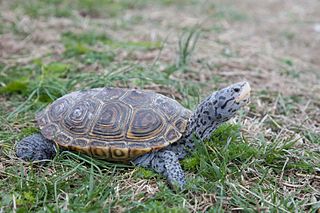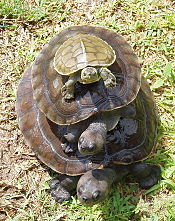
Loxocemus bicolor, the sole member of the monotypic family Loxocemidae and commonly known as the Mexican python, Mexican burrowing python and Mexican burrowing snake, is a species of python-like snake found in Mexico and Central America. No subspecies are currently recognized. Analyses of DNA show that Loxocemus is most closely related to the true pythons and the sunbeam snakes.

The spotted turtle, the only species of the genus Clemmys, is a small, semi-aquatic turtle that reaches a carapace length of 8–12 cm (3.1–4.7 in) upon adulthood. Their broad, smooth, low dark-colored upper shell, or carapace, ranges in its exact colour from black to a bluish black with a number of tiny yellow round spots. The spotting patterning extends from the head, to the neck and out onto the limbs. Sexually mature males have a concave plastron and a long, thick tail. By contrast, sexually mature females possess a flat plastron and have a tail that is noticeably shorter and thinner than that of mature males. Mature males also have a dark iris and face; females typically have a yellow or orange iris and a similarly coloured face that is distinctly lighter than the males'. Juveniles appear female-like in this regard, and at maturity males begin to develop darker features.

The Arakan forest turtle is a critically endangered turtle species native to the Arakan Hills in western Myanmar and the bordering Chittagong Hill Tracts in Bangladesh. The Arakan forest turtle is a semiterrestrial turtle, meaning it can survive in aquatic as well as terrestrial habitats, but adults prefer living in terrestrial habitats.

The spiny turtle is a South-East Asian turtle species. It inhabits lowland and hill rainforest, usually dwelling in the vicinity of small streams in hill areas up to 1,000 m above sea level. It is found in Brunei, Indonesia, Malaysia, Myanmar, the Philippines, Singapore, and Thailand.

The Alabama red-bellied cooter or Alabama red-bellied turtle, is native to Alabama. It belongs to the turtle family Emydidae, the pond turtles. It is the official reptile of the state of Alabama.

The Sonora mud turtle, also known as the Sonoyta mud turtle, is a species of turtle in the Kinosternidae family. It is found in Mexico and the United States. The Sonoran mud turtle species is heavily influenced by its environment. Depending on the amount of water available due to fixed water sources or rainfall, is how tolerant the mud turtle is to drought. The species drought tolerance is extremely variable, depending on its environment.

The Malaysian giant turtle or Bornean river turtle is a species of turtle in the family Bataguridae. It is monotypic within the genus Orlitia. It is found in Indonesia and Malaysia.

The brown wood turtle or brown land turtle is a species of turtle in the family Geoemydidae. The species is endemic to Central America and northern South America.

Rhinoclemmys is a genus of turtles in the family Geoemydidae, the only genus in the subfamily Rhinoclemmydinae. Member species of the genus are commonly known as the Neotropical wood turtles and are the only geoemydids known from the Americas. As such, they have adapted to a wide range of habitats, which is reflected in the species' common names.

The black wood turtle, or black river turtle is one of nine species of turtle in the genus Rhinoclemmys, which is in the family Geoemydidae. It is found in Costa Rica, Honduras, Nicaragua, and Panama.

The large-nosed wood turtle is one of nine species of turtle in the genus Rhinoclemmys of the family Geoemydidae. It is found in Colombia and Ecuador.

The spotted box turtle is a species of turtle in the family Emydidae. The species is endemic to the Sierra Madre Occidental in Mexico.

Terrapins are a group of several species of small turtle living in fresh or brackish water. Terrapins do not form a taxonomic unit and may not be closely related. Many belong to the families Geoemydidae and Emydidae.
Wood turtle may refer to:

The ornate or painted wood turtle is one of nine turtle species of the genus Rhinoclemmys of the family Geoemydidae. There are four recognized subspecies.

The furrowed wood turtle is a species of turtle belonging to the genus Rhinoclemmys of the family Geoemydidae found in the Yucatán Peninsula and adjacent regions of Central America.

The painted wood turtle or spot-legged wood turtle is a species of turtle belonging to the genus Rhinoclemmys of the family Geoemydidae.

The Mexican mud turtle, is a species of mud turtle in the family Kinosternidae. Endemic to Mexico, it is found in Aguascalientes, Colima, Durango, Guanajuato, Guerrero, Hidalgo, Jalisco, Michoacán, México, Morelos, Nayarit, Oaxaca, Puebla, Queretaro, San Luis Potosí, Sinaloa, Sonora, Tamaulipas and Zacatecas, where they inhabit moist environments, such as shallow ponds, lakes, rivers or intermediate temp. tropical forest areas.
The lesser Chinese softshell turtle is a species of turtle in the family Trionychidae. It is endemic to China, where it inhabits a small range in Guangxi and Hunan provinces. Populations of this species in Vietnam and Hainan are now considered to belong to a separate species, the spotted softshell turtle. There is some controversy within researchers over whether or not P. parviformis is a valid species, but a study in 2015 reaffirmed it as such.


















